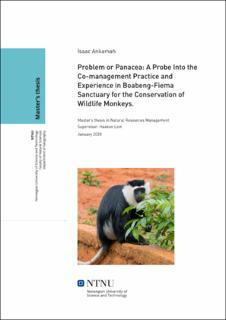| dc.description.abstract | Summary
Boabeng-Fiema Monkey Sanctuary, over the years, has welcomed and witnessed multiple external stakeholders assisting with the management of the wildlife conservation. External stakeholders, including the wildlife division, district assembly, Ghana tourism board, and a legal expert, gravitated to the dual communities. In addition to the stakeholders, the conservation area has also welcomed the formation of organizations such as the management committee (MC) and the board to facilitate management activities. These stakeholders' arrival required sharing management functions, adjusting of positions, and ensuring power distribution between the various stakeholders available in the twin villages- making it a co-management system.
However, the practice of co-management over the years in Boabeng-Fiema Monkey Sanctuary has produced multifaceted outcomes. For this reason, this study aims to uncover the pluralistic management approach's impacts by identifying the challenges and benefits of co-management and ascertain the type of co-management utilized in Boabeng and Fiema's protected area. In other to accomplish this task, the study adopts an interview technique for data collection. Face to face interview was used to gather data from local residents/stakeholders in both Boabeng and Fiema communities. On the other hand, a focus group interview was employed to obtain information from management stakeholders, including the management committee members, the five external stakeholders (board).
Respondents agree in their numbers that the pressing challenges residents and external stakeholders face together in the co-management system include the hike in conflict, unfair benefits, and costs allocated and break down in relationships among actors. On the bright side, many respondents also admitted having benefited from the co-management structure because it has helped create a conflict mitigation platform and has equally helped improve the relationship between stakeholders and encouraging grassroots participation. The field results indicate that the type of co-management practiced in the conservation area management is the coordination. In discussing some of the results, Human-Wildlife Conflict (HWC) is employed to analyze conflict issues in the communities between wildlife-human and human-human. Political Ecology is also used to discuss benefits and cost allocations present in the sanctuary co-management. Lastly, the results of grassroots participation improvement and coordination co-management are equally addressed in the discussion chapter. | |
